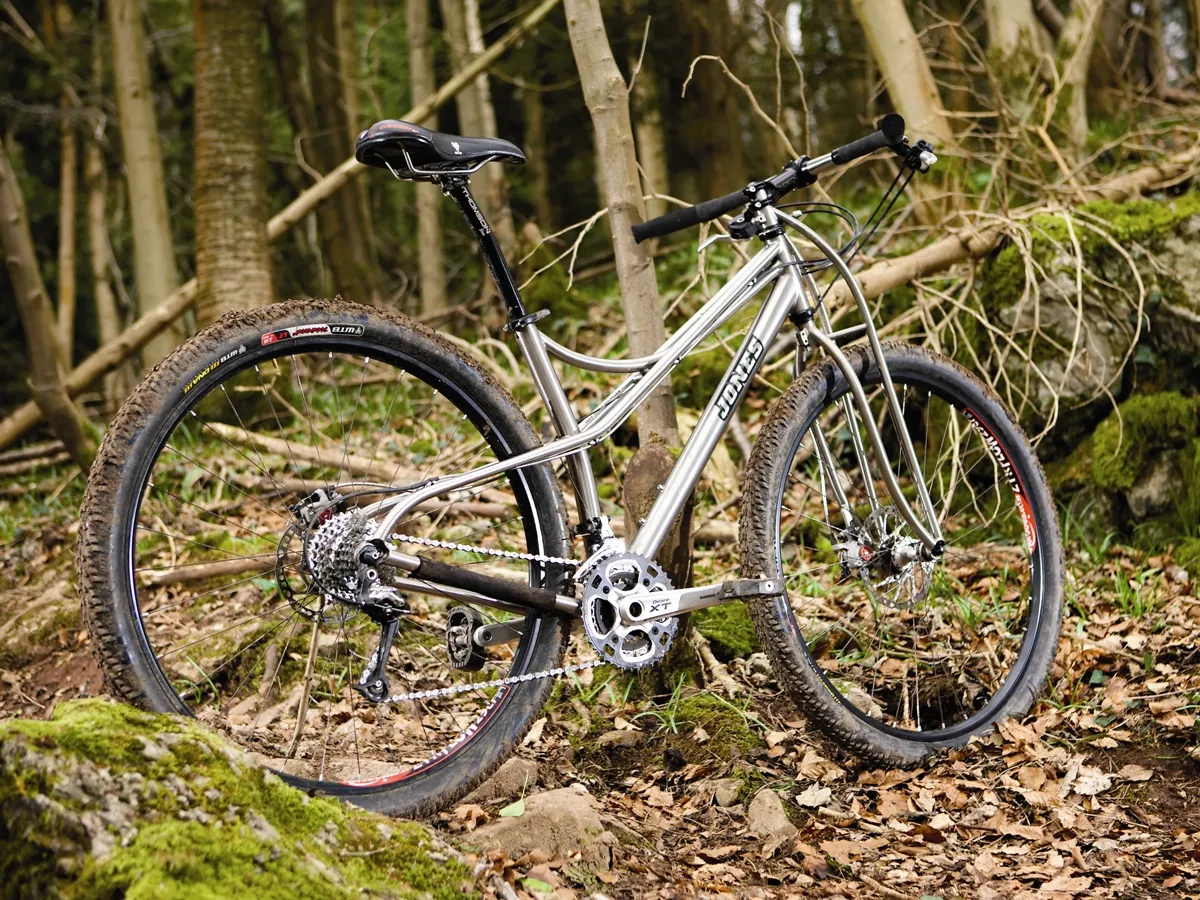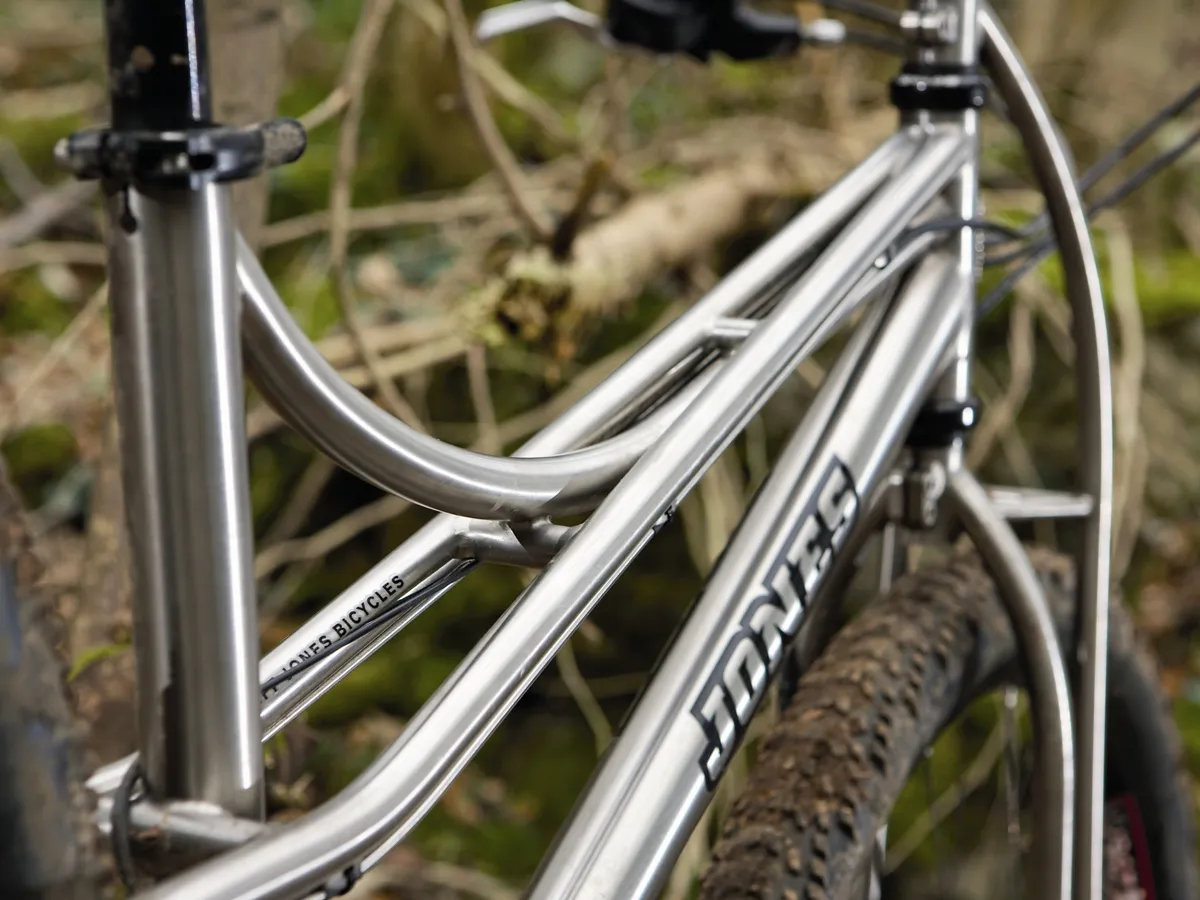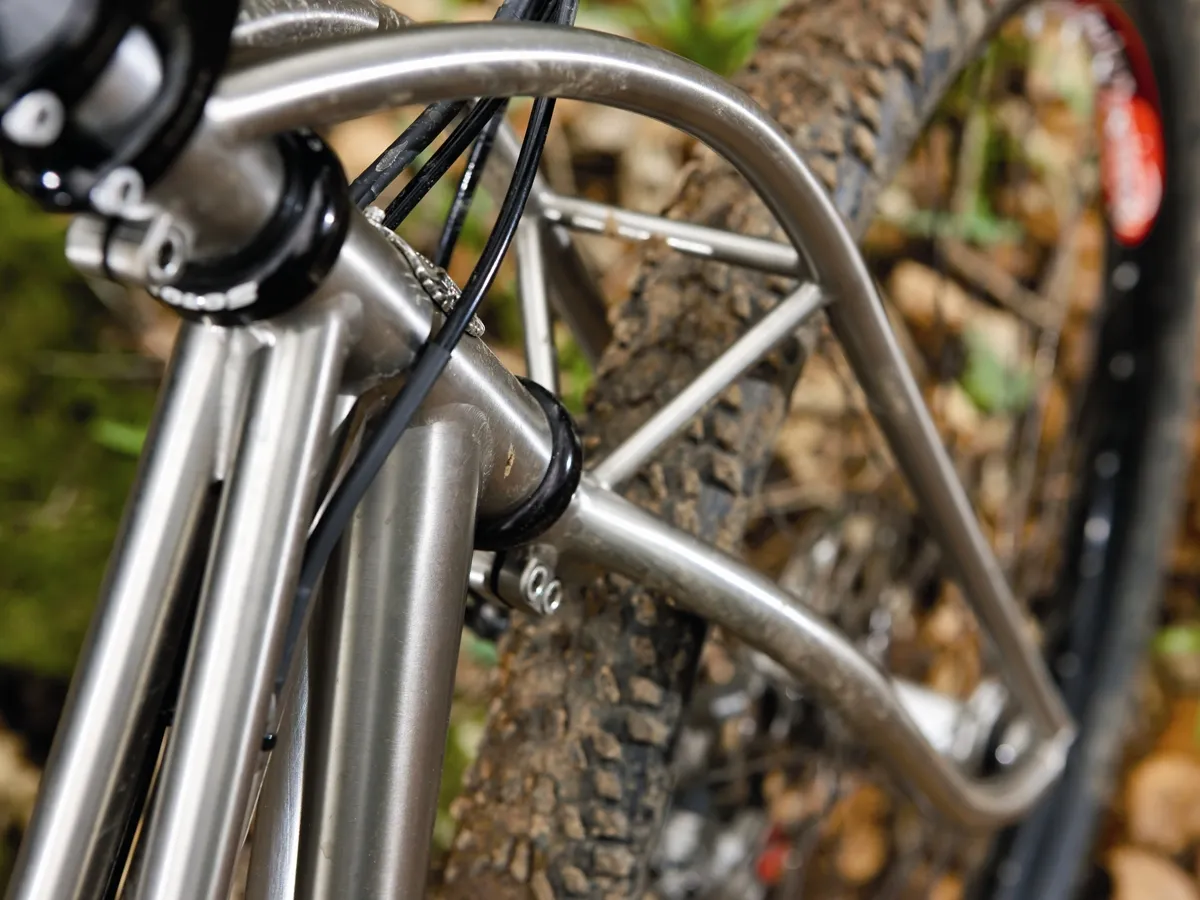This Merlin Metalworks version of Jeff Jones’s unique chassis rides better than other premium big-wheelers with fixed forks and big tyres, and we’ve definitely been seduced by the unique H-Bar handlebar.
It’s hard to get away from the fact that even the best-designed rigid bike in the world – and this is probably it – still needs much more care and attention as you ride than the average full-suspension rig.
That’s totally missing the point, of course. The Jones is a bike that’ll be cherished to a point of worship by almost anyone who buys it.
The Jones approach
Jeff Jones is a big fan of 29-inch wheels, rigid forks and one-geared bikes. This is a massive clue to some design aspects of his unique spaceframe, Truss fork and H-Bar. Because 29in wheels roll more smoothly on rough ground, big-wheeler fans often choose to use rigid forks. It works the other way round too, and those who choose rigid forks often seem to also choose 29in wheels and fatter tyres, too, because they offer more comfort.
And that H-Bar shape? Well, the back-sweep of the bar offers a surprisingly efficient hand position for low-cadence stand-up climbs. This is perfect for single-gear riders who need a lot of back and arm power to conquer climbs, but other riders will also appreciate the H-Bar for its choice of hand positions.
Frame & fork: one of a kind; rigid but not quite
It’s impossible to separate Jeff Jones’s philosophy from the design and construction of his custom-built frames. Jones explains that they’re designed in harmony to deliver a rigid bike that’s anything but. We’ve seen several of his custom framesets and every one is a little bit different, with structural features to suit the individual rider’s body shape, weight, ride demands and component specifications.
Jones’ bikes have slacker seat angles and shorter top tubes than most mountain bikes. Combined with a slacker head angle and long fork rake, this results in your weight being set back a tad more than would be ideal on a bike with a suspension fork. Short chainstays emphasise the easy-to-lift front end and your centre of gravity is low and set back for relaxed control and low upper body impact.
Practicality and adaptability on the Merlin-built Jones is superb. The eccentric bottom bracket lets you run with single sprockets without chain length/tensioning issues, or you can raise the bottom bracket height half an inch for more ground clearance. Tyre clearance is generous, and you can opt for the extra-fat Truss fork if you want to run a giant tyre up front for more shock absorption. The design means that standover height is lower than anything out there.
Ride & handling: back to the future
The handling reminds us of slack-angled rigid bikes we used to ride 15 years ago. If suspension forks had never been invented, there would be more bikes like this. That isn’t a derogatory comment, though – suspension has allowed frame designers to think less about frame design because forks do much of the donkey work. Jeff Jones, on the other hand, has set out to show how comfy and controllable a bike can be without suspension – or rather, with suspension that comes only from the tube structure of the frame, fork and handlebar, the ground-levelling effect of big wheels, big tyres and an ideal ride position. We reckon he’s managed it better than any rigid bike we’ve ridden, but only slightly better.
It’s that ‘slightly better’ thing that can be confusing. The Jones is an easy-to-ride bike that copes with climbs, descents and singletrack incredibly well, but so do a whole lot of other – much cheaper – 25lb bikes. What sets the Jones apart is that it feels just a bit more forgiving over rough terrain than other rigid-forked, big-wheeled titanium bikes we’ve tried, and that makes it easier to ride.
In a world where everyone seems to be arguing about what the best suspension system is, you can make a point of out-riding most of them on this. The Truss fork might not be pretty, but its ride feel is amazing – it copes with rocky terrain without flexing back on big hits or under hard braking. It makes you realise how much other forks flex and flutter.
Any downsides? Yes, if you’re convinced that a five-inch-travel suspension bike is what you really want. Otherwise we found just one small foible: using just the chassis and tyres to absorb shocks obviously results in a barely damped recoil effect that, on a hard-edged bump, creates a noticeable kickback through the seat and bars. It’s no big deal, but it reminds you that you can’t ride a bike like this with reckless abandon.
Equipment: your choice
We suspect most buyers will simply opt for a frame, fork and H-Bar, but our test bike came with a full Deore XT drivetrain with dual-control shift levers (because they work best on H-Bars), Avid cable pull discs and a Stan’s No Tubes ZTR rimmed wheelset shod with 2.55in WTB Weirwolf treads. A Thomson stem and seat post were fitted, plus a WTB saddle. Either way, there’s a three-month waiting list, but Jeff Jones will put your package together himself.
Verdict: very special
If you’re prepared to spend £4000 on this bike, it’s because you want to buy into a design approach and philosophy that’ll be seen as beautifully unique, fresh, pure and enlightened by some, and pointlessly elitist by others.
We loved the ride and appreciated the thoughts behind the design, but we’re not going to guide you on price. The Jones might not make you ride faster than other 25lb £4000 bikes, and it’ll be bought on passion more than rationale, but anyone who buys one will become a Jones evangelist. There’s something very special going on here.
Designer Jeff Jones on the Spaceframe
The best way to find out about the unique Jeff Jones approach is to contact him directly. He’s passionate about what he does and is happy to talk about your needs, but prepare to be dissuaded!
Jones is convinced that fashion rules function way too much in mountain biking these days. It’s not hard to see that he works totally the other way round. He explains, “Every tube size, tube position, tube shape, brace rib, frame angle and parts choice on my bikes is there for a good reason: to make the rider feel more at ease and ride better.
“I assumed full suspension was the future when I worked at GT, but my passion and flair for riding made me want to see how far I could progress with rigid frame and fork design. Not everyone likes the way my bikes look, but they’re the logical conclusion of focusing a lot of time and energy into making a rigid chassis work properly.”
So does he think he’s designed the perfect bike?
“My philosophy is that if you let each part or system do what it needs to do to the fullest extent — without interference from other parts or systems — then the bike will respond in performance,” says Jones.
“When parts or systems might interfere with one another, I give priority to the part or system that demands priority, based first on safety, second on reliability, third on desired performance and fourth on lowest weight.”
And there are very good reasons why his frames look the way they do.
“Traditionally, designers will stiffen or soften a frame’s feel simply by increasing or decreasing the tube diameters,” says Jones.
“But that way, to get the frame stiffer laterally you must accept a vertically stiffer ride — using ultra compact designs can reduce this. Conversely, to make a vertically more compliant/comfortable frame you must normally accept more lateral flex. By using a carefully designed and constructed 3D spaceframe, lateral flex/twisting is minimised.”






